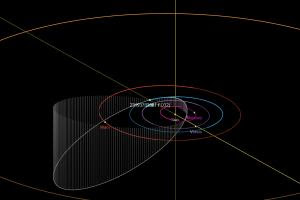Maunakea Telescope Tracking Flyby of Asteroid the Size of Golden Gate Bridge
From the summit of the Big Islandʻs Maunakea, astronomers will be tracking an asteroid estimated to be the size of the Golden Gate Bridge that will make a “close pass” by Earth on March 21.
The Infrared Telescope Facility, which is operated by the University of Hawaiʻi Institute for Astronomy, will be used to closely analyze the characteristics of asteroid 2001 FO32 as it passes Earth. The closest distance will be 1.25 million miles away or about five times the distance from the Moon.
This is a good opportunity for astronomers to use the telescope to improve the tracking of hazardous objects that threaten the planet.
“The object’s size and composition can be measured using infrared instruments,” said John Rayner, Director of the Infrared Telescope Facility (IRTF). “Measuring the physical characteristics of large Near-Earth Objects (NEOs) is vital to expanding critical knowledge of hazardous objects should one ever threaten our planet. Determining whether an impacting asteroid might break up in the Earth’s atmosphere or travel all the way to the ground is important for understanding how widespread the potential damage might be, and the resulting hazard to human life.”
NASA funds the 3.2-meter telescope, which is one of several observatories on Maunakea and Maui’s Haleakalā that play a key role in the nation’s planetary defense system. IRTF’s workhorse infrared spectrograph, SpeX built by IfA astronomers, will provide a more precise understanding of 2001 FO32’s composition.
“We’re trying to do geology with a telescope,” said Vishnu Reddy, associate professor at the University of Arizona’s Lunar and Planetary Laboratory in Tucson. “We’re going to use the IRTF to get the infrared spectrum to see its chemical makeup. Once we know that, we can make comparisons with meteorites on Earth to find out what minerals 2001 FO32 contains.”
According to NASA scientists, if the asteroid is identified as iron-rich, that would mean it’s denser and more massive than a stony asteroid of similar size. More than 95% of NEOs the size of 2001 FO32 or larger have been discovered, tracked and cataloged. None of the objects in the catalog has any chance of impacting Earth throughout the next century. Still, efforts continue to discover all asteroids that could pose an impact hazard. The more information gathered about these objects, the better mission designers can prepare to deflect them should any threaten the Earth in the future.
On July 20, 2020, the UH Pan-STARRS1 telescope atop Haleakalā discovered an asteroid the length of about two school buses that was just days away from closely passing Earth. Several telescopes around the world, including the Canada-France-Hawaiʻi Telescope on Maunakea, assisted with rapid follow-up observations to verify the asteroid’s orbit. The search for NEOs is funded by NASA’s Planetary Defense Coordination Office through its Near-Earth Object Observations Program.

















